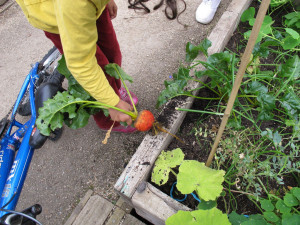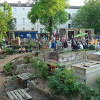Drawing on new approaches to thinking about care as complex, other and self-regarding behaviours, which is partially socially constructed, this research project explores the interrelationships between sustainability, health and quality of life. Care about and for ourselves as individuals, and for our wider communities embodies issues of sustainability, health and quality of life. The research investigates these issues by actively engaging with groups involved in promoting local food production and consumption in Glasgow. The project is funded by the University of Glasgow’s Knowledge Exchange Fund and is concerned with developing new resources about local food projects in partnership with existing local groups.
The term ‘urban agriculture’ (UA) is one we might not associate with an old industrial city like Glasgow but like other old industrial cities in the UK, a discourse of UA is finding its way into local government policy initiatives. For example, during the first week of our research we attended a conference organised by Glasgow City Council (GCC) in partnership with the Soil Association Scotland entitled ‘Glasgow, Sustainable Food City’. This involved a series of talks and discussions geared towards implementing a sustainable food strategy for Glasgow. The event elicited a range of ideas: “more school gardens”, “a much better map of available and potential growing land”, “a vibrant street food culture” and much more.
While the event noted above marks an important juncture in the City Council’s approach to UA, of crucial concern to our research is an already existing network of grassroots community food initiatives in the city. In the same week as the GCC event, we attended a meeting held by the Glasgow Local Food Network (GLFN). The GLFN is an informal network of community organisations and individuals from across the city “that are passionate about local food and strive to produce more of what we eat and eat more of what we produce” (http://glasgowlocalfood.blogspot.co.uk/). The passion and commitment of local growers across much of Europe, like the GLFN, has helped push UA up the policy agenda. Similarly, for a sustainable food strategy policy to be effective, it must value and utilize the wealth of knowledge being cultivated at the ground level.

The value of grassroots community food initiatives and UA more generally is quantifiable. For example, we can measure: a decrease in food miles that comes with local food production and consumption; the acreage of unproductive urban space revitalized through a variety urban agricultural practices, and the volume of materials recycled in such practices (e.g. timber for raised beds; food waste for compost; water capture and storage). Other potential values of UA are less easily quantified but no less important for people committed to creating sustainable communities of care in our city. These relate to, amongst other things, awareness of environmental and human health, community cohesion and resilience and the co-production and sharing of knowledge and skills. It should also be noted that modern urban agricultural practices are, for some, deeply embedded in issues of political struggle. Many UA practitioners understand their work as part of an ongoing struggle to de-commodify urban spaces and secure an urban commons for future generations.
Our project began in earnest three weeks ago and in that short time we have encountered all of the issues raised above and more. With a clear methodology beginning to develop, the next five months should be an exciting time for all involved.
John is a researcher at the University of Glasgow in the Adam Smith Business School working with Professors Deirdre Shaw, Andy Cumbers and Robert McMaster on the Caring City project.
To find more about local food communities in Glasgow, visit:
- The Woodlands Community Garden
- The Willowbank Community Garden
- The Children’s Garden
- And many more local initiatives on The Glasgow Local Food Network


